Investigation of Heating Time Effects on Viscosity Profiles of Cassava Flour and Wheat Flour Blends
| Received 24 May, 2024 |
Accepted 13 Jun, 2024 |
Published 14 Jun, 2024 |
Background and Objective: Viscosity is a crucial property in food science, affecting the texture, mouthfeel and overall quality of various food products. This study investigates the effect of heating time on the viscosity profiles of cassava and wheat flour blends. Materials and Methods: Flour blends with varying ratios of cassava to wheat flour (100:0, 90:10, 80:20, 70:30, 50:50, 30:70 and 0:100) were analyzed using a viscometer in a temperature-controlled environment. Viscosity measurements were recorded at regular intervals during heating to capture changes over time. Results: The pure cassava flour exhibited higher viscosity compared to pure wheat flour, due to cassava’s higher starch content. As the proportion of wheat flour increased in the blends, a decrease in viscosity was observed. This trend was attributed to the dilution effect of wheat flour’s lower viscosity. The viscosity profiles showed distinct differences based on the flour composition and heating duration, providing valuable insights into the rheological behavior of these blends. The findings are crucial for optimizing processing parameters in food production, particularly for products requiring specific textural attributes. Conclusion: This study’s results can guide the formulation of new flour-based products, such as gluten-free baked goods and thickening agents, enhancing their quality and consumer acceptability by tailoring heating time and flour proportions. Further research is recommended to explore the effects of other variables on the rheological properties of flour blends, ensuring successful application in the food industry.
| Copyright © 2024 Imoisi et al. This is an open-access article distributed under the Creative Commons Attribution License, which permits unrestricted use, distribution, and reproduction in any medium, provided the original work is properly cited. |
INTRODUCTION
Viscosity is a crucial property in food science, affecting the texture, mouthfeel and overall quality of various food products1-5. Understanding how processing conditions, such as heating time, influence viscosity is essential for optimizing product formulations and ensuring consistent quality. This study investigates the effect of heating time on the viscosity profiles of cassava and wheat flour blends.
Cassava (Manihot esculenta) and wheat (Triticum aestivum) flours are staple ingredients in many culinary traditions and processed food products6-11. Cassava flour, derived from the tuberous roots of the cassava plant, is valued for its gluten-free properties, making it a popular alternative for individuals with gluten intolerance or celiac disease. Additionally, cassava flour has unique gelatinization properties, which can significantly affect the texture of food products12-16. Wheat flour, on the other hand, is a widely used ingredient known for its gluten content, which provides elasticity and structure to doughs and batters17-20.
Blending cassava and wheat flours can combine the desirable properties of both ingredients, potentially enhancing the nutritional profile, texture and overall quality of food products21-24. However, the rheological properties of such blends are influenced by various factors, including the proportions of each flour and the processing conditions, particularly heating time20.
Heating induces gelatinization, a process where starch granules absorb water and swell upon heating, leading to an increase in viscosity. The extent of gelatinization and the resulting viscosity are affected by the type of starch present, the temperature and the duration of heating25-28. For cassava and wheat flour blends, understanding the relationship between heating time and viscosity can provide valuable insights for food manufacturers aiming to optimize the textural properties of their products29-32.
This study aims to elucidate the effect of heating time on the viscosity profiles of cassava and wheat flour blends. By systematically varying the heating duration and measuring the corresponding viscosity changes, the work seeks to identify optimal processing conditions that maximize the desired textural attributes. The findings from this research can inform the development of improved food products and processing techniques, contributing to the broader field of food science and technology.
MATERIALS AND METHODS
Study area and sites: Benin City is a major urban center located in Edo State, Nigeria, positioned at approximately 6.34°N Latitude and 5.63°E Longitude, it sits at an elevation of 88 m above sea level. With an estimated population of 1,125,058 residents, Benin City is the most densely populated city in Edo State33-35.
Sample collection and analysis
Cassava flour: Mature raw cassava roots weighing 25 kg and aged over twelve months, were harvested from a farm within the Department of Agricultural Science Education, College of Education, Ekiadolor-Benin, Edo State, Nigeria. The study was conducted from February, 2014 to July, 2015. The roots were thoroughly washed to remove sand and soil and then peeled using stainless knives. After another wash to eliminate any remaining dirt, the tubers were sliced into smaller pieces and spread on a clean, flat surface for air and sun drying. This drying phase facilitated fermentation and moisture reduction. Once dried, the cassava chips were milled into cassava flour, which was then sieved to reduce the fiber content. The sieved cassava flour was packaged in air-tight containers as samples for the research and its color was noted to be white. Additionally, wheat grains were purchased from Uselu Market, Benin City, Edo State, Nigeria. The grains were subjected to physical examination, sorting, cleaning and drying before being ground into whole wheat flour at the mill. This flour was also packaged in air-tight containers and used as samples for the research. The color of the whole wheat flour was observed to be off-white36,37.
Preparation of composite cassava flour and incorporation with wheat flour: Composite cassava flour was created using the straight dough method outlined by Imoisi et al.38. The cassava and wheat flours were measured on a laboratory scale and the dough was mixed to achieve optimal consistency at a low speed of 85 rpm for 1 min. The cassava flour was substituted with wheat flour at varying percentages: 0, 10, 20, 30, 50, 70 and 100%. These substitutions corresponded to the following ratios: CS/WT(100/0)%, CS/WT(90/10)%, CS/WT(80/20)%, CS/WT(70/30)%, CS/WT(50/50)%, CS/WT(30/70)% and CS/WT(0/100)% (Table 1).
| Table 1: | Ratios of cassava flour to wheat flour | |||
| Sample code | Composition |
| CS/WT(100/0) | Control (100 g cassava flour) |
| CS/WT(90/10) | 90% cassava flour+10% wheat flour |
| CS/WT(80/20) | 80% cassava flour+20% wheat flour |
| CS/WT(70/30) | 70% cassava flour+30% wheat flour |
| CS/WT(50/50) | 50% cassava flour+50% wheat flour |
| CS/WT(30/70) | 30% cassava flour+70% wheat flour |
| CS/WT(0/100) | 100% wheat flour |
Rheological determination of composite cassava flour and wheat flour
Tools and equipment manufacturers: The viscometer, rheometer and other tools and equipment used in this study were procured from manufacturers including Hanna Instruments (Woonsocket, Rhode Island, USA), Thermo Fisher Scientific (Waltham, Massachusetts, USA) and Mettler Toledo (Columbus, Ohio, USA), among others.
Viscometer or rheometer: A viscometer or rheometer was used to measure the viscosity of the flour blends. The selection of the instrument was based on the anticipated viscosity range of the samples and the required measurement accuracy. The instrument was calibrated according to the manufacturer’s instructions prior to use.
Temperature control: The viscometer or rheometer was set up in a temperature-controlled environment to ensure a constant temperature throughout the analysis. This was achieved using a water bath, temperature-controlled chamber or a built-in heating/cooling system, depending on the instrument design.
Experimental procedure: A small amount of the prepared flour blend sample was placed onto the measuring platform or spindle of the instrument. The measurement settings were adjusted to the desired parameters, including shear rate (if applicable) and measurement time. The measurement was then started, allowing the instrument to apply a controlled shear force to the sample and measure the resulting viscosity.
Data collection: Viscosity measurements were recorded at regular intervals or specific time points during the heating process. The instrument ensured real-time or continuous data acquisition to provide accurate viscosity profiling.
Heating time variation: Each sample was subjected to varying heating times according to the experimental design. Viscosity measurements were recorded at each heating time interval to capture changes in viscosity over time.
Data analysis: The viscosity data collected was analyzed using software provided by the instrument manufacturer or compatible data analysis tools. Viscosity profiles were plotted as a function of heating time for each flour blend sample to visualize changes over time. Relevant rheological parameters, such as shear stress, shear rate and apparent viscosity, if applicable, were calculated.
Interpretation and reporting: The viscosity profiles were interpreted in relation to the experimental objectives and hypotheses. Observed trends, differences, or similarities between the wheat flour and watermelon rind flour blends under varying heating times were discussed. The results were reported with appropriate statistical analyses and graphical representations to support the findings.
Quality control and validation: Periodic validation of instrument performance involves running calibration checks and utilizing reference standards. Quality control measures were implemented to ensure the reproducibility and reliability of viscosity measurements.
Statistical analysis: Statistical analysis was conducted using the BMDP statistical package, specifically employing the BMDP 2R program for stepwise multiple regression. Results were reported as the mean of triplicate analyses39-42.
RESULTS AND DISCUSSION
Figure 1 illustrates the influence of heating time on the viscosity of a sample consisting of 100% cassava flour (CS/WT). It provides insights into the viscosity profile of pure cassava flour under varying heating conditions.
Figure 2 examined the effect of heating time on viscosity, but for a sample composed of 100% wheat flour (CS/WT). It showcases the viscosity characteristics of pure wheat flour during different heating intervals.
Figure 3 explored the influence of heating time on the viscosity of a blend containing 90% cassava flour and 10% wheat flour (CS/WT). It investigates how the addition of wheat flour affects the viscosity profile of the blend compared to pure cassava flour.
Figure 4 examined a blend with 80% cassava flour and 20% wheat flour (CS/WT), this figure investigates the impact of heating time on viscosity. It provides insights into how altering the ratio of cassava to wheat flour affects the rheological behavior of the blend during heating.
Figure 5 focused on a blend composed of 70% cassava flour and 30% wheat flour (CS/WT), this figure evaluates the influence of heating time on viscosity. It highlights the viscosity changes resulting from variations in the proportion of cassava and wheat flour in the blend.
Figure 6 investigated a blend with equal parts cassava and wheat flour (50% each) (CS/WT), this figure examines the effect of heating time on viscosity. It provides insights into the rheological properties of the blend when the two flours are present in equal proportions.

|
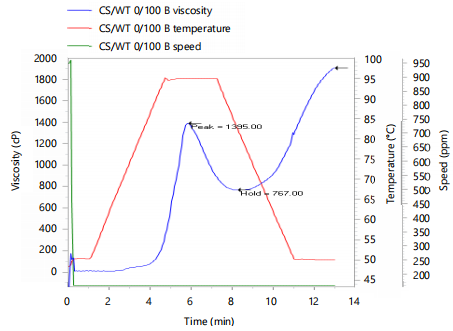
|
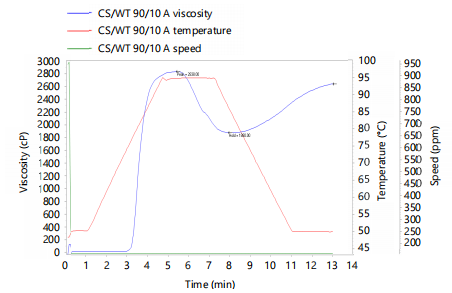
|
Figure 7 analyzes a blend containing 30% cassava flour and 70% wheat flour (CS/WT), focusing on the influence of heating time on viscosity. It explores the viscosity profile of the blend when the proportion of wheat flour is significantly higher than that of cassava flour.
The viscosity profiles of flour blends consisting of cassava (CS) and wheat (WT) flours, under varying heating times, offer valuable insights into their rheological behavior, which is crucial for understanding their suitability for various food applications42,43.
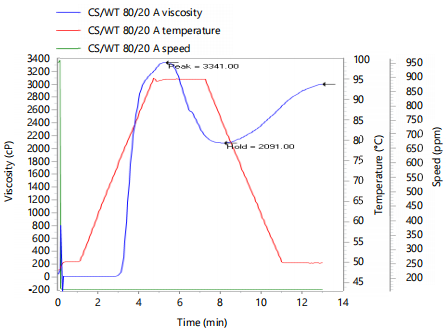
|
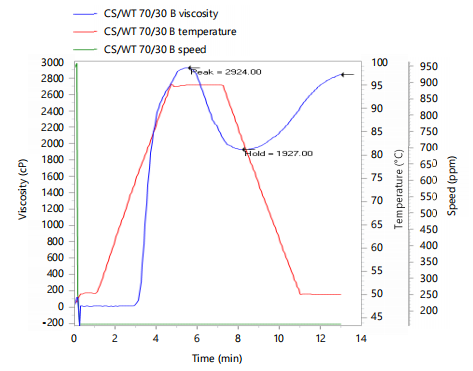
|
Starting with Fig. 1 and 2, which depict the viscosity of 100% cassava and wheat flour samples, respectively, the distinct rheological properties inherent to each flour type were observed. Cassava flour typically exhibits higher viscosity due to its high starch content and unique granular structure, while wheat flour, characterized by smaller particle size and lower starch content, tends to have lower viscosity. These differences underline the importance of considering flour type in food formulation to achieve desired product characteristics23,44.

|
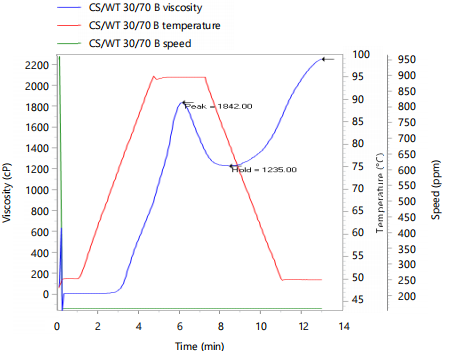
|
Figure 3-7 explore the viscosity changes in blends of cassava and wheat flours with varying compositions and heating times. As the proportion of cassava flour decreases and wheat flour increases in the blends, a gradual decrease in viscosity is observed. This trend can be attributed to the dilution effect of cassava flour’s high viscosity by the lower viscosity of wheat flour. Furthermore, with increasing heating time, there may be alterations in the starch structure, leading to changes in viscosity26,45.
Blends with higher cassava flour content (Fig. 3 and 4) generally exhibit higher viscosities, which is consistent with the behavior of pure cassava flour. However, as the proportion of wheat flour increases (Fig. 5-7), the viscosity decreases, reflecting the dilution effect mentioned earlier. Notably, the rate of viscosity change may vary depending on the specific composition and heating conditions, as observed in the different slopes of the viscosity curves26,27.
Overall, this comprehensive analysis highlights the intricate interplay between flour composition, heating time and viscosity in CS/WT flour blends. Understanding these relationships is essential for optimizing processing parameters and formulating flour-based products with desired texture, mouthfeel and sensory attributes. Additionally, these findings contribute to the utilization of cassava and wheat flours in diverse food applications, catering to both nutritional and functional needs46,47. The study’s findings highlight the significant impact of heating time on the viscosity of both pure cassava flour and its blends with wheat flour. Understanding these effects is crucial for optimizing the processing parameters in food production, particularly for products that rely on specific textural attributes. The rheological behavior insights gained here can guide the formulation of new flour-based products, enhancing their quality and consumer acceptability21. These results can be directly applied in the food industry to develop and refine products such as gluten-free baked goods, sauces and thickening agents where texture and viscosity are key attributes47.
By tailoring the heating time and the proportion of cassava and wheat flour, manufacturers can create products with the desired consistency and stability. This study provides valuable insights into the rheological behavior of cassava and wheat flour blends under different heating conditions, with significant implications for the food industry7,11,47. By applying these findings, manufacturers can enhance product quality and innovate new formulations. However, further research and careful consideration of the study’s limitations are essential for successful real-world application. Further research should be conducted to explore the effects of other variables such as pH, moisture content and different types of wheat flours on the rheological properties of flour blends. The findings should be used to innovate and improve the formulation of gluten-free and other specialty products. Additionally, insights from this study should be implemented into industrial processes to optimize heating times for achieving the desired viscosity in various food products. The study focuses on cassava and wheat flours, so the results may not be directly applicable to other types of flours. Experiments were conducted under controlled laboratory conditions, which may differ from real-world food processing environments. The transition from laboratory-scale findings to industrial-scale applications may present challenges that need to be addressed through pilot testing and validation.
CONCLUSION
This study examined the effects of heating time on the viscosity profiles of cassava and wheat flour blends with varying compositions. The results demonstrated that pure cassava flour exhibited higher viscosity due to its high starch content, whereas pure wheat flour showed lower viscosity. As the proportion of wheat flour increased in the blends, a decrease in viscosity was observed, reflecting the dilution effect of wheat flour’s lower viscosity. The viscosity changes were also influenced by heating time, with longer heating times generally leading to alterations in starch structure and viscosity. The findings highlight the importance of considering both flour composition and heating time in food formulation to achieve desired textural properties. Blends with higher cassava content exhibited higher viscosities, while those with higher wheat content showed lower viscosities. This information is valuable for optimizing processing parameters and developing new flour-based products, such as gluten-free baked goods and thickening agents, where specific viscosity and texture are critical. Further research should explore additional variables, such as pH and moisture content, to fully understand their impact on the rheological properties of flour blends. Implementing these findings in industrial processes can help manufacturers enhance product quality and consistency.
SIGNIFICANCE STATEMENT
Investigating the effect of heating time on the viscosity of cassava and wheat flour blends is crucial for enhancing food processing methods and product quality. This study explores the rheological properties of these flour mixtures, demonstrating how heat influences their viscosity. By examining a range of compositions, from pure cassava flour to various cassava and wheat flour ratios, it underscores the relationship between heating duration, flour composition and viscosity. These findings help optimize processing parameters, enabling food scientists to create innovative products with specific sensory qualities. This research contributes to food science and technology, offering valuable insights for producing high-quality cassava and wheat flour-based products.
REFERENCES
- Afoakwa, E.O., E.J. Kongor, G.A. Annor and R. Adjonu, 2010. Acidification and starch behaviour during co-fermentation of cassava (Manihot esculenta Crantz) and soybean (Glycine max Merr) into gari, an African fermented food. Int. J. Food Sci. Nutr., 61: 449-462.
- Agbon, C.A., E.O. Ngozi and O.O. Onabanjo, 2010. Production and nutrient composition of fufu made from a mixture of cassava and cowpea flours. J. Culinary Sci. Technol., 8: 147-157.
- Chinyere, I. and I.U. Julius, 2020. Spectroscopic determination of sugar components of Vitex doniana fruit syrup following derivatization. Nat. Sci., 18: 67-76.
- Jitngarmkusol, S., J. Hongsuwankul and K. Tananuwong, 2008. Chemical compositions, functional properties and microstructure of defatted macadamia flours. Food Chem., 110: 23-30.
- Ceballos, H., T. Sánchez, N. Morante, M. Fregene and D. Dufour et al., 2007. Discovery of an amylose-free starch mutant in cassava (Manihot esculenta Crantz). J. Agric. Food Chem., 55: 7469-7476.
- Imoisi, C., J.U. Iyasele and S.E. Okhale, 2021. Proximate and acute toxicity profile of Vitex doniana (black plum) fruit. J. Chem. Soc. Nigeria, 46: 276-282.
- Adebowale, A.R.A., L.O. Sanni and A. Kuye, 2006. Effect of roasting methods on sorption isotherm of tapioca grits. Electron. J. Environ. Agric. Food Chem., 5: 1649-1653.
- Imoisi, C., J.U. Iyasele, E.E. Imhontu, U.R. Orji and S.A. Okhale, 2021. Phytochemical and antioxidant capability of Vitex doniana (black plum) fruit. J. Chem. Soc. Niger., 46: 191-196.
- Charles, A.L., Y.H. Chang, W.C. Ko, K. Sriroth and T.C. Huang, 2004. Some physical and chemical properties of starch isolates of cassava genotypes. Starch, 56: 413-418.
- Egbeneje, V.O., S.E. Okhale, C. Imoisi, I.O. Ogbogo and O. Ojo, 2023. Evaluation of the inhibitive properties of silver nanoparticles in Senna occidentalis root extract as corrosion inhibitor of mild steel. Tanzania J. Sci., 49: 655-663.
- Curvelo, A.A.S., A.J.F. de Carvalho and J.A.M. Agnelli, 2001. Thermoplastic starch-cellulosic fibers composites: Preliminary results. Carbohydr. Polym., 45: 183-188.
- Imoisi, C. and U.C. Michael, 2020. Comparative physicochemical and proximate analyses of different extracts of Persea americana. J. Chem. Soc. Niger., 45: 1139-1146.
- Imoisi, C., J.U. Iyasele, U.C. Michael and E.E. Imhontu, 2020. The effects of watermelon rind flour on the functional and proximate properties of wheat bread. J. Chem. Soc. Niger., 45: 978-986.
- Ajenu, C.O., C. Imoisi, E.E. Imhontu and U.R. Orji, 2021. Comparative evaluation of the proximate and micro-nutritional benefits of pawpaw, carrots, turmeric and coconut. J. Food Technol. Nutr. Sci., 3.
- Daramola, B. and K.O. Falade, 2006. Enhancement of agronomical values: Upstream and downstream opportunities for starch and starch adjuncts. Afr. J. Biotechnol., 5: 2488-2494.
- Josiah, J.G., J.Y. Adama, Z. Jiya, O.M. Abah and C. Imoisi, 2023. In vitro anthelmintic activities of stem and root barks extracts of Parkia biglobosa on infective larvae and adult of Haemonchus contortus. Afr. J. Biotechnol., 22: 26-38.
- Ozoh, C.A., C. Imoisi and J.U. Iyasele, 2023. Effect of pH and duration of fermentation on the quality characteristics of garri. Pak. J. Nutr., 22: 45-51.
- Ağar, B., H. Gençcelep, F.T. Saricaoğlu and S. Turhan, 2016. Effect of sugar beet fiber concentrations on rheological properties of meat emulsions and their correlation with texture profile analysis. Food Bioprod. Process., 100: 118-131.
- Okhale, S.E., I. Chinyere, S.A. Fidelis and M.I. Aboh, 2021. Antiproliferative, growth inhibitory and antibacterial activities of thymol isolated from the leaf of Ocimum gratissimum L. Life Sci. J., 18: 67-76.
- Kurhade, A., S. Patil, S.K. Sonawane, J.S. Waghmare and S.S. Arya, 2016. Effect of banana peel powder on bioactive constituents and microstructural quality of chapatti: Unleavened Indian flat bread. J. Food Meas. Charact., 10: 32-41.
- Blazek, J., E.P. Gilbert and L. Copeland, 2011. Effects of monoglycerides on pasting properties of wheat starch after repeated heating and cooling. J. Cereal Sci., 54: 151-159.
- Imoisi, C., J.U. Iyasele, E.E. Imhontu, D.O. Ikpahwore and A.O. Okpebho, 2020. Pasting properties of composite of cassava and wheat flours. J. Chem. Soc. Niger., 45: 1157-1163.
- Yaich, H., H. Garna, B. Bchir, S. Besbes and M. Paquot et al. 2015. Chemical composition and functional properties of dietary fibre extracted by Englyst and Prosky methods from the alga Ulva lactuca collected in Tunisia. Algal Res., 9: 65-73.
- Okhale, S.E., I. Chinyere, M.I. Aboh and U.A. Osunkwo, 2021. Effects of semisynthetic modifications on the antimicrobial activities of ethyl acetate extract of Mitracarpus villosus (Sw.) DC aerial part. Nat. Sci., 19: 36-41.
- Chinyere, I., I.U. Julius and O.E. Samuel, 2021. Determination of the flavoring components in Vitex doniana fruit following hydrodistillation extraction. Am. J. Food Nutr., 9: 69-75.
- Daramola, B. and S.A. Osanyinlusi, 2006. Production, characterization and application of banana (Musa spp) flour in whole maize. Afr. J. Biotechnol., 5: 992-995.
- Delcour, J.A., J. Vansteelandt, M.C. Hythier and J. Abécassis, 2000. Fractionation and reconstitution experiments provide insight into the role of starch gelatinization and pasting properties in pasta quality. J. Agric. Food Chem., 48: 3774-3778.
- Ajenu, C.O., M.E. Ukhun, C. Imoisi, E.E. Imhontu, L.E. Irede and U.R. Orji, 2021. Characterization and stability studies of egusi melon seed oil (Citrullus colocynthis L.). J. Chem. Soc. Niger., 46: 238-244.
- Aremu, M.O., O. Olaofe and E.T. Akintayo, 2007. Functional properties of some Nigerian varieties of legume seed flours and flour concentration effect on foaming and gelation properties. J. Food Technol., 5: 109-115.
- Saikia, S. and C.L. Mahanta, 2016. In vitro physicochemical, phytochemical and functional properties of fiber rich fractions derived from by-products of six fruits. J. Food Sci. Technol., 53: 1496-1504.
- Josiah, J.G., J.Y. Adama, E.H. Edim, I. Chinyere and J. Zipporah, 2024. Acute toxicity profile of crude methanolic stem bark extract of Parkia biglobosa in West African Dwarf (Wad) goats. J. Biosci. Biotechnol. Discovery, 9: 10-22.
- Okhale, S.E., P.O. Oladosu, M.I. Aboh, C. Imoisi and J.J. Gana, 2022. In-vitro evaluation of Eucalyptus citriodora leaf essential oil and extracts on selected pathogens implicated in respiratory tract infections. Int. J. Pharmacogn., 9: 195-201.
- Edogun, P.I., C. Imoisi and J.U. Iyasele, 2024. Study on the effect of Ficus exasperata aqueous leaf extract on the rate of lactic acid formation of fermented milk. Trends Appl. Sci. Res., 19: 72-82.
- Omenai, F.I., C. Imoisi and J.U. Iyasele, 2024. Physico-chemical and pasting characteristics of cassava, wheat flours and their composite blends. Asian Sci. Bull., 2: 333-344.
- Umanya, O.J., P.I. Edogun and C. Imoisi, 2024. Comparative study of chitosan and alum for water purification: A case study of Jesse River, Nigeria. Trends Appl. Sci. Res., 19: 104-111.
- Imoisi, C., J.U. Iyasele, D.O. Ikpahwore and A.O. Okpebho, 2023. The effects of watermelon rind flour on the proximate properties of wheat cake. Int. J. Nutr. Res. Health, 2.
- Imoisi, C. and J.U. Iyasele, 2024. Investigation of heating time effects on viscosity profiles of cassava flour and citrus flour blends. Asian J. Emerging Res., 6: 22-30.
- Imoisi, C., J.U. Iyasele and A.O. Okpebho, 2023. The effects of citrus vesicle flour on the functional and proximate properties of cassava bread. Pak. J. Nutr., 22: 19-26.
- Okhale, S.E., V.O. Egbeneje and C. Imoisi, 2021. GC-MS evaluation of palm oil as benign extraction medium for bioactive constituents of Ocimum gratissimum L and Bryophyllum pinnatum (Lam.). J. Am. Sci., 17: 46-53.
- Okhale, S.E., C. Imoisi, A. Aliyu, J.G. Josiah and V. Egbeneje, 2024. Synergistic antimicrobial activities and phytochemical analysis of leaf extracts from Sarcocephalus latifolius, Morinda lucida and Anogeissus leiocarpus. Asian Sci. Bull., 2: 425-434.
- Imoisi, C. and S.E. Okhale, 2024. Chemical composition analysis of Eucalyptus citriodora essential oil using GC-MS and NMR spectroscopy. Trends Agric. Sci., 3: 83-90.
- Macagnan, F.T., L.P. da Silva and L.H. Hecktheuer, 2016. Dietary fibre: The scientific search for an ideal definition and methodology of analysis, and its physiological importance as a carrier of bioactive compounds. Food Res. Int., 85: 144-154.
- Okhale, S.E., N. Amuzie, C. Imoisi and J.A. Ibrahim, 2022. Phytochemical and HPLC-UV-DAD chromatographic characterization of stem bark extracts of Pentaclethra macrophylla Benth used for management of diabetes mellitus in Nigeria. N. Y. Sci. J., 15: 41-49.
- Rolls, B.J., E.A. Bell, V.H. Castellanos, C. Mosuk, C.L. Pelkman and M.L. Thorwart, 1999. Energy density but not fat content of foods affected energy intake in lean and obese women. Am. J. Clin. Nutr., 69: 863-871.
- Butt, M.S. and R. Batool, 2010. Nutritional and functional properties of some promising legumes protein isolates. Pak. J. Nutr., 9: 373-379.
- Okhale, S.E., H.O. Egharevba, C. Imoisi, J.A. Ibrahim and I.A. Jegede, 2022. Gas Chromatography-Mass Spectrometry (GC-MS) analysis of the essential oil from Nigerian Artemisia annua L. at different growth stages. Nat. Sci., 20: 49-54.
- Cummings, J.H. and A.M. Stephen, 2007. Carbohydrate terminology and classification. Eur. J. Clin. Nutr., 61: S5-S18.
How to Cite this paper?
APA-7 Style
Imoisi,
C., Omenai,
F.I., Iyasele,
J.U. (2024). Investigation of Heating Time Effects on Viscosity Profiles of Cassava Flour and Wheat Flour Blends. Research Journal of Botany, 19(1), 10-20. https://doi.org/10.3923/rjb.2024.10.20
ACS Style
Imoisi,
C.; Omenai,
F.I.; Iyasele,
J.U. Investigation of Heating Time Effects on Viscosity Profiles of Cassava Flour and Wheat Flour Blends. Res. J. Bot 2024, 19, 10-20. https://doi.org/10.3923/rjb.2024.10.20
AMA Style
Imoisi
C, Omenai
FI, Iyasele
JU. Investigation of Heating Time Effects on Viscosity Profiles of Cassava Flour and Wheat Flour Blends. Research Journal of Botany. 2024; 19(1): 10-20. https://doi.org/10.3923/rjb.2024.10.20
Chicago/Turabian Style
Imoisi, Chinyere, Frederick Ideyienmhi Omenai, and Julius Uche Iyasele.
2024. "Investigation of Heating Time Effects on Viscosity Profiles of Cassava Flour and Wheat Flour Blends" Research Journal of Botany 19, no. 1: 10-20. https://doi.org/10.3923/rjb.2024.10.20

This work is licensed under a Creative Commons Attribution 4.0 International License.



